There are many things that are important to know when going to a new job site with industrial equipment. Because of the power restrictions and requirements for different pieces of equipment and job sites, it is important to know what to look for.
Understanding connectors and reading nameplates is a very common inquiry. In this blog, we will discuss the important information to be aware of on connectors and nameplates, and show you how to effectively read and understand them so you can be fully prepared as you head into your next job site.
Connectors
There are many types of connectors but they all have 3 basic pieces of information on them that is important to know:
- Voltage
- Maximum Current
- Number of Poles/Phases
The following 3 pictures show 3 examples of different markings found on connectors on our equipment.
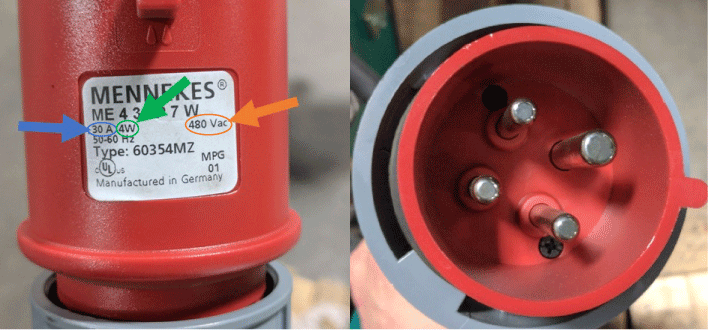
The sticker example shown above is generally found on larger connectors, this is an example of a pin and sleeve connector (often seen on industrial equipment because it insulates the power delivery from the dirt, moisture, chemicals etc. that may be present on the job site. They’re also very durable, and their strength is ideal for avoiding accidental disconnection)
We’ve added arrows to the picture above to highlight the important information to be aware of:
- Blue Arrow: “30 A (amps)”= Maximum Current
- Green Arrow: ”4W”= In this case the number of wires – 4 Wires
- Orange Arrow: “480 Vac”- In short, Vac stands for (V)olts of (a)lternating (c)urrent = Voltage
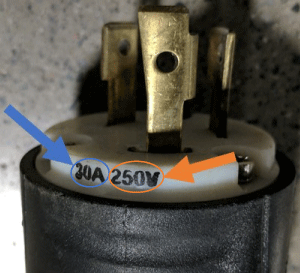 Other connectors have the specifications stamped right on them. This example is a male (with prongs / what you plug in) twist lock.
Other connectors have the specifications stamped right on them. This example is a male (with prongs / what you plug in) twist lock.
The information here is:
- Blue Arrow: “30A(amps)” = Maximum Current
- Orange Arrow: “250V” = Voltage
You will notice that there is no information about the number of poles, wires, or phases. This is generally done on single phase connectors.
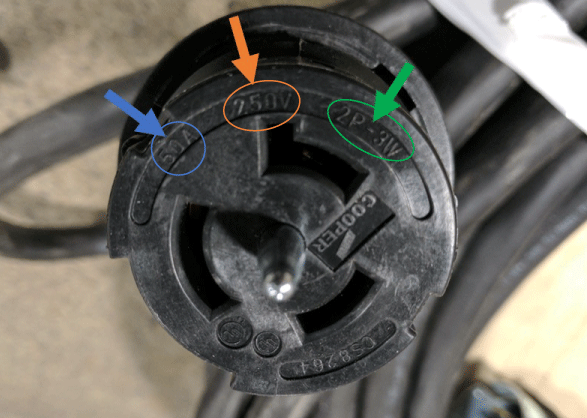
The third style of markings are molded into the connector; this is on a female (the receiving end / what you plug in to) twist lock connector.
You’ll notice the following information:
- Blue Arrow: “50A (amps)” = Maximum Current
- Orange Arrow: “250V” = Voltage
- Green Arrow: “2P-3W” = the number of poles and number of wires.
On this connector, the number of wires includes the ground wire and the number of poles indicates the number of power carrying wires the connector can handle.
Nameplates
A second question that we often get is, what is the actual current draw of the machine? Well, given the availability of different sized connectors and other factors, the actual current draw will often be less than the rated current of the connector. Most equipment will have a nameplate that will tell you the maximum current draw, if this is not available you must calculate the approximate maximum current. In order to get the approximate maximum current draw of a piece of equipment, look at each main component and add their maximum current’s together.
For example, a simple grinder just has a motor connected to a starter. In this configuration, the FLA (Full load Amps) of the motor indicates the maximum current that the grinder would draw.
Nameplates can be very simple or complex. As an example, we will look at 2 nameplates from different motors and highlight the most important information on them.
There are 2 main pieces of information on the following nameplates that we are interested in that can be listed slightly differently.
- FLA = Full load Amps (Indicates the maximum current that would be drawn)
- PF = Power Factor (this is used when sizing a generator or transformer to be used with the piece of equipment)
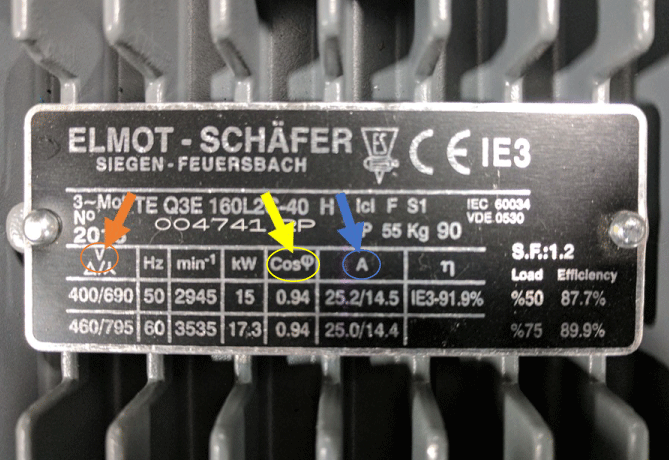 This is a European made motor and they are generally labeled as follows:
This is a European made motor and they are generally labeled as follows:
- Blue Arrow: FLA = marked as “A” for Amps. It is listed for each voltage that the motor is capable of, which is highlighted by the Orange Arrow.
- Yellow Arrow: PF (Power Factor) = labeled as “Cosɸ”
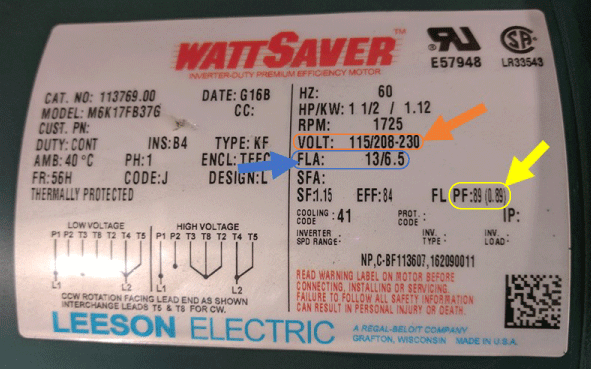
This is a North American made motor:
- Blue Arrow: FLA- again listed for both voltages as indicated by the Orange Arrow
- Yellow Arrow: PF (Power Factor)
Remember, if you ever have any difficulties finding or understanding the information on your connectors or nameplates can simply ask the manufacturer, rental house or dealer to identify or point out the following…
For Connectors:
- Voltage (listed as Vac, or V)
- Maximum Current (listed as A (amps)
- Number of Poles/Phases and Wires (listed as P and W)
And for Nameplates:
- Full load Amps (listed as FLA)
- Power Factor (listed as PF)

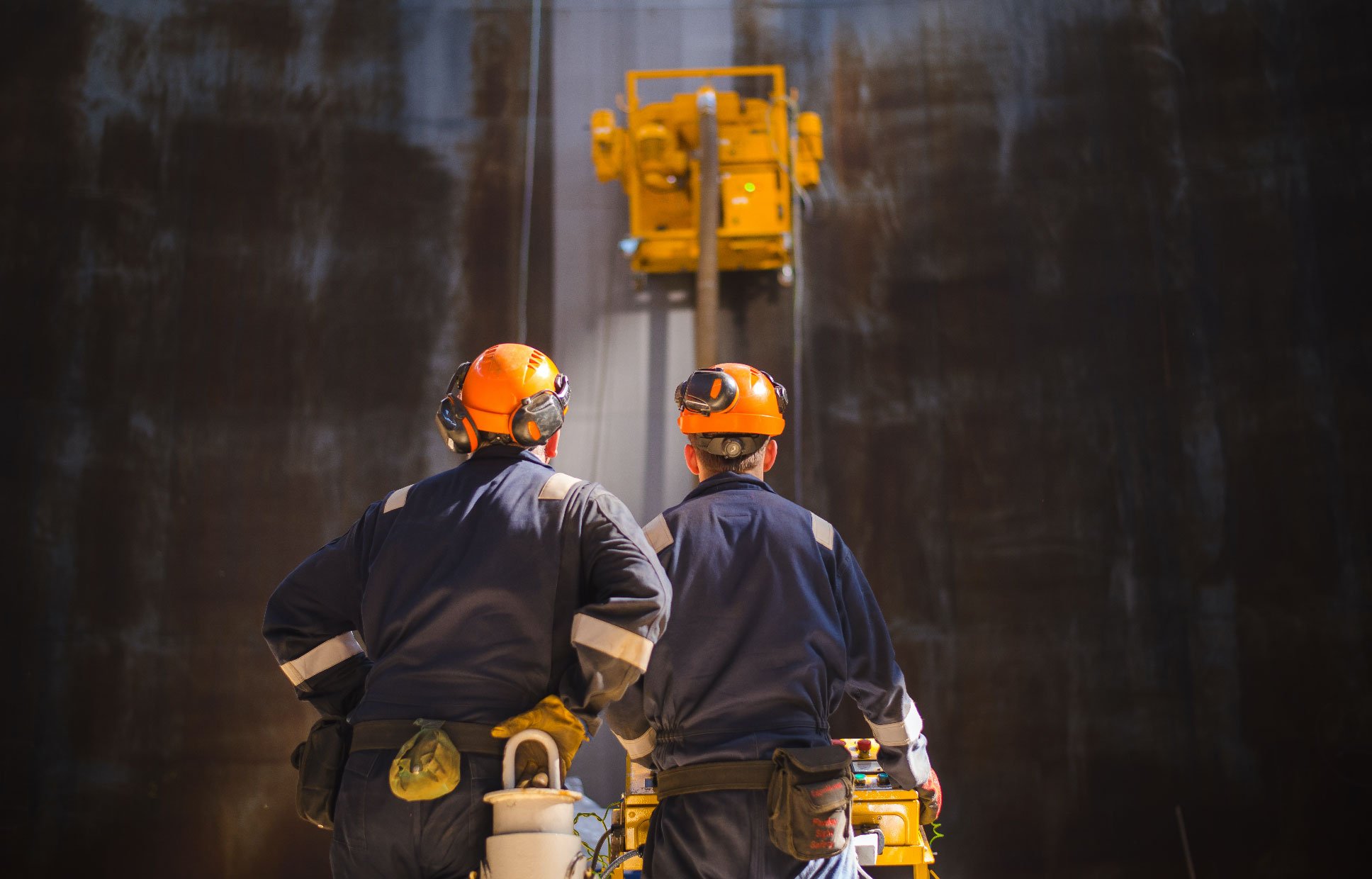
 By
By 